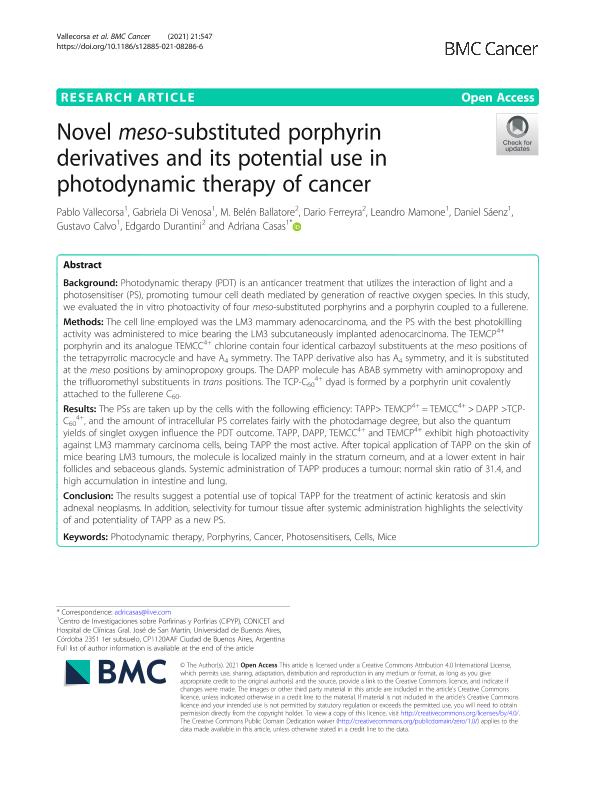Artículo
Novel meso-substituted porphyrin derivatives and its potential use in photodynamic therapy of cancer
Vallecorsa, Pablo Daniel ; Di Venosa, Gabriela Mariana
; Di Venosa, Gabriela Mariana ; Ballatore, María Belén
; Ballatore, María Belén ; Ferreyra, Darío David
; Ferreyra, Darío David ; Mamone, Leandro Ariel
; Mamone, Leandro Ariel ; Saenz, Daniel Alberto
; Saenz, Daniel Alberto ; Calvo, Gustavo Hernán
; Calvo, Gustavo Hernán ; Durantini, Edgardo Néstor
; Durantini, Edgardo Néstor ; Casas, Adriana Gabriela
; Casas, Adriana Gabriela
 ; Di Venosa, Gabriela Mariana
; Di Venosa, Gabriela Mariana ; Ballatore, María Belén
; Ballatore, María Belén ; Ferreyra, Darío David
; Ferreyra, Darío David ; Mamone, Leandro Ariel
; Mamone, Leandro Ariel ; Saenz, Daniel Alberto
; Saenz, Daniel Alberto ; Calvo, Gustavo Hernán
; Calvo, Gustavo Hernán ; Durantini, Edgardo Néstor
; Durantini, Edgardo Néstor ; Casas, Adriana Gabriela
; Casas, Adriana Gabriela
Fecha de publicación:
12/2021
Editorial:
BioMed Central
Revista:
BMC Cancer
ISSN:
1471-2407
Idioma:
Inglés
Tipo de recurso:
Artículo publicado
Clasificación temática:
Resumen
Background: Photodynamic therapy (PDT) is an anticancer treatment that utilizes the interaction of light and a photosensitiser (PS), promoting tumour cell death mediated by generation of reactive oxygen species. In this study, we evaluated the in vitro photoactivity of four meso-substituted porphyrins and a porphyrin coupled to a fullerene. Methods: The cell line employed was the LM3 mammary adenocarcinoma, and the PS with the best photokilling activity was administered to mice bearing the LM3 subcutaneously implanted adenocarcinoma. The TEMCP4+ porphyrin and its analogue TEMCC4+ chlorine contain four identical carbazoyl substituents at the meso positions of the tetrapyrrolic macrocycle and have A4 symmetry. The TAPP derivative also has A4 symmetry, and it is substituted at the meso positions by aminopropoxy groups. The DAPP molecule has ABAB symmetry with aminopropoxy and the trifluoromethyl substituents in trans positions. The TCP-C604+ dyad is formed by a porphyrin unit covalently attached to the fullerene C60. Results: The PSs are taken up by the cells with the following efficiency: TAPP> TEMCP4+ = TEMCC4+ > DAPP >TCP-C604+, and the amount of intracellular PS correlates fairly with the photodamage degree, but also the quantum yields of singlet oxygen influence the PDT outcome. TAPP, DAPP, TEMCC4+ and TEMCP4+ exhibit high photoactivity against LM3 mammary carcinoma cells, being TAPP the most active. After topical application of TAPP on the skin of mice bearing LM3 tumours, the molecule is localized mainly in the stratum corneum, and at a lower extent in hair follicles and sebaceous glands. Systemic administration of TAPP produces a tumour: normal skin ratio of 31.4, and high accumulation in intestine and lung. Conclusion: The results suggest a potential use of topical TAPP for the treatment of actinic keratosis and skin adnexal neoplasms. In addition, selectivity for tumour tissue after systemic administration highlights the selectivity of and potentiality of TAPP as a new PS.
Palabras clave:
CANCER
,
CELLS
,
MICE
,
PHOTODYNAMIC THERAPY
,
PHOTOSENSITISERS
,
PORPHYRINS
Archivos asociados
Licencia
Identificadores
Colecciones
Articulos(CIPYP)
Articulos de CENTRO DE INVEST. SOBRE PORFIRINAS Y PORFIRIAS
Articulos de CENTRO DE INVEST. SOBRE PORFIRINAS Y PORFIRIAS
Citación
Vallecorsa, Pablo Daniel; Di Venosa, Gabriela Mariana; Ballatore, María Belén; Ferreyra, Darío David; Mamone, Leandro Ariel; et al.; Novel meso-substituted porphyrin derivatives and its potential use in photodynamic therapy of cancer; BioMed Central; BMC Cancer; 21; 1; 12-2021; 547-559
Compartir
Altmétricas



